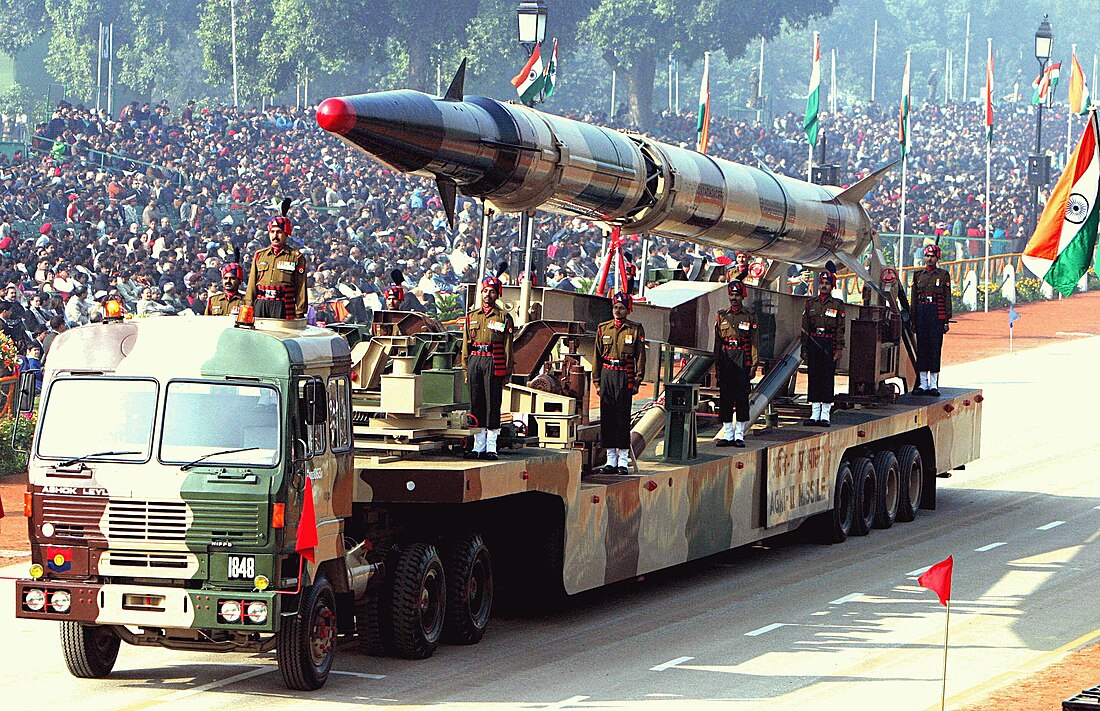Agni-II
Indian medium-range ballistic missile From Wikipedia, the free encyclopedia
Agni-II (lit. 'Fire'), is the second strategic ballistic missile of the Agni family envisaged to be the mainstay of the Indian missile-based strategic nuclear deterrence. The Agni-II is a medium-range ballistic missile (MRBM) with two solid fuel stages and a Post Boost Vehicle (PBV) integrated into the missile's Re-entry Vehicle (RV). The Agni's manoeuvring RV is made of a carbon-carbon composite material that is light and able to sustain high thermal stresses of re-entry, in a variety of trajectories. The Agni-IIA is a more advanced version of Agni-II, albeit with more sophisticated and lighter materials, yielding a better range and operating regime. Agni-IIA was later renamed as Agni-IV plugging the gap between Agni-II and Agni-III. While the first test of Agni-IV in December 2010 was a failure, the second test flight in November 2011 was a success[10] Agni-II, developed as part of medium- and long-range Agni series of missile systems, has already been inducted into the Armed Forces.[11]

| Agni-II | |
|---|---|
 An Agni-II on a road-mobile launcher displayed at the Republic Day Parade 2004. | |
| Type | Medium Range Ballistic Missile |
| Place of origin | India |
| Service history | |
| In service | Active[1] |
| Used by | Strategic Forces Command |
| Production history | |
| Designer | Defence Research and Development Organisation |
| Manufacturer | Bharat Dynamics Limited |
| Unit cost | ₹25 crore (US$2.9 million) to ₹35 crore (US$4.1 million)[2] |
| No. built | 12 (2017 est.)[3] |
| Specifications | |
| Mass | 16,000 kg (35,000 lb) |
| Length | 21 m[4] |
| Diameter | 1.3 m |
| Warhead | Conventional high explosive-unitary, penetration, sub-munitions, incendiary, thermobaric, strategic nuclear weapon |
| Warhead weight | 1,000 kg (2,200 lb)[5] |
| Engine | Multi-stage solid rocket |
| Propellant | Solid fuel |
Operational range | 2,000–3,500 km[6][5] |
| Flight ceiling | 405 km[7] |
| Flight altitude | 230 km[4] |
| Maximum speed | 3.5 km/s (14,040 km/h)[8] |
Guidance system | Mid-course: Ring laser gyro inertial navigation system. Optionally augmented by GPS/NavIC satellite guidance Terminal: Radar scene correlation. Upgraded to active radar homing. |
| Accuracy | 30–40 m CEP[5][9] |
Launch platform | Ashok Leyland/Tata transporter erector launcher |
On 17 May 2010, the trial was conducted with a Strategic Forces Command (SFC) of nuclear-capable Agni-II ballistic missile, with a range of 2,000 kilometres from the Wheelers Island off Orissa coast thus making Agni-II missile operational by army.[12] US Air Force National Air and Space Intelligence Center estimating that as of June 2017 less than 10 launchers were operationally deployed,[13] operated by the 335 Missile Group of Regiment of Artillery at Secunderabad using 12 TEL vehicles.[14]
Agni-II can reach all of Pakistan and most parts of south and southeastern China.[15]
See also
Related development
Related lists
References
Wikiwand - on
Seamless Wikipedia browsing. On steroids.
